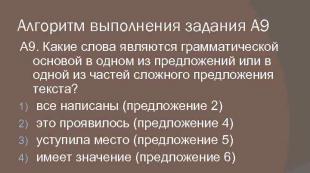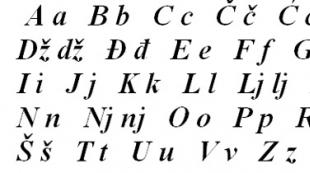Alexander Pushkin - Cloud: Verse. The last cloud of the scattered storm! Alone you rush across the clear azure Last cloud
"Cloud" is a vivid example of the landscape poetry of Alexander Sergeevich Pushkin. Despite the fact that the poem was written in the late period of his work, when the poet gradually deviates from his traditional romantic principles, it absorbed the main features of Russian romanticism.
The work is dated April 13, 1835. A little later, in May of the same year, readers will see the new creation for the first time, published in the Moscow Observer magazine. Despite the fact that later the poet's legacy was more than once subjected to negative criticism from many literary researchers, "Cloud" became proof of the talent of the mature Pushkin, for which it was named a kind of hymn to summer rain and human harmony with nature.
The poem is written in an atypical form for Pushkin - a four-foot amphibrach with truncation in the last two lines of each stanza (incomplete feet can be traced). Female and male rhymes alternate. This allows to give the text not only a smooth, moderate rhythm, but also a certain similarity with philosophical memoir reflections.
Some literary scholars suggest that the work is presented in the form of a response to the Decembrist uprising. Social hardships ten years ago troubled the soul of the Russian poet for a long time.
We bring to your attention the text of the verse by A.S. Pushkin's "Cloud":
The last cloud scattered storm!
Alone you are rushing across the clear azure.
You alone cast a dull shadow
You alone sadden a joyous day.
You recently wrapped around the sky,
And the lightning wrapped menacingly around you;
And you made a mysterious thunder
And the greedy land watered with rain.
Enough, hide! The time has passed
The ground refreshed and the storm swept by
And the wind, caressing the leaves of the wood,
Heaven drives you from the reassured.
The poem "Cloud" refers to the landscape and philosophical lyrics of Alexander Sergeevich Pushkin, and, although at this time the poet had already begun to move away from romanticism, this work is completely sustained in this direction. It is necessary to read the verse "Cloud" by Alexander Sergeevich Pushkin carefully, because this work is not accidental. It was written on April 13, 1835. The next day, the poet was supposed to get an appointment with the head of the Third Section, A.K. Benckendorff, to whom he applied to publish his own newspaper. The poet hoped that the storm clouds over his head would finally dissipate and life would return to normal. The image of the cloud is classic for romantic fiction. It is a symbol of sadness, anxiety, danger. The poet, as it were, describes everything that happens in his life, reveals his fears and hopes to the reader. In the first part of the poem, a cloud is just approaching, bringing fear and despondency to the poet, in the second the storm has already broken out and the long-awaited rain has poured on the earth, but in the third the cloud has gone, fears and anxieties have dissipated. The poet, with the help of symbols, images and allegories, tries to convey to the reader the idea that everyday storms are a temporary, passing phenomenon.
The poem also carries a different semantic load. Pushkin, using the antithesis, draws the storm and the calm after it with watercolor precision, as if saying that the time of his glory has passed, that it is necessary to leave the “poetic stage”, to make way for young talents. At this time, the poet was really going through a certain creative crisis, he and his works were no longer so admired by the readers, and critics directly said that "Pushkin is not the same." Some researchers believe that "Cloud" is a poem dedicated to the decade that has passed since the Decembrist uprising. The poet, in his work, seems to say that the time of storms, when his poems were really needed, is over. In this poem, Pushkin uses many different epithets that enhance the "picturesque" of the story, convey the mood of the original house and the ensuing peace, personifications revive nature and the main "hero" of the story - a cloud. The poet resorts to the method of alternating female and male rhymes, which is atypical for landscape works. The rhythm of the piece is very even, calming, measured. Learning this work by heart is easy. This work was recognized as the best landscape poem by Pushkin. The richness and beauty of artistic images impresses readers today. It is usually disassembled in literature lessons in grade 9.
The text of Pushkin's poem "Cloud" can be downloaded from our website or read completely online.
The poem "Cloud" was written on April 13, 1835, and a month later it was published in the "Moscow Observer". This magazine began to be published in 1835, existed for 4 years, and Pushkin was among its first authors.
Some literary critics saw in the masterfully written, colorful poem "Cloud" a hint of the Decembrist uprising that took place 10 years ago. Others believe that the poet compares himself to this cloud, they see a hint that he must leave, making way for the young.
The next day, after writing the poem, Pushkin was supposed to meet with the chief of the gendarmes, Alexander Benckendorff, to get an answer to his request to publish his own newspaper. Some biographers of Pushkin try to associate this event with a poem written the day before. Although it is difficult to see any connection in this.
It is impossible not to agree with Belinsky, who believed that the poem "Cloud" is an example of "Pushkin's contemplation of nature." Once, after a pouring, refreshing rain, the poet saw a cloud lingering in the sky. This painting served as a theme for the creation of a lyrical sketch.
The last cloud of the scattered storm!
Alone you are rushing across the clear azure.
You alone cast a dull shadow
You alone sadden a joyous day.You recently wrapped around the sky,
And the lightning wrapped menacingly around you;
And you made a mysterious thunder
And the greedy land watered with rain.Enough, hide! The time has passed
The ground refreshed and the storm swept by
And the wind, caressing the leaves of the wood,
Heaven drives you from the reassured.
You recently wrapped around the sky,
And the lightning wrapped menacingly around you;
And you made a mysterious thunder
And the greedy land watered with rain.
Enough, hide! The time has passed
The ground refreshed and the storm swept by
And the wind, caressing the leaves of the wood,
Heaven drives you from the reassured.
1835 year
"The Cloud" by Alexander Sergeevich Pushkin was written in 1835.
« Late Pushkin achieves amazing spiritual enlightenment in prose and in lyric creativity. Delight in front of the rebellious beauty of sensual passions disappears, dark clouds and blizzards of vain earthly anxieties disappear, a tender contemplation of spiritual beauty in nature and in man appears.
As nature is purified and renewed in a thunderstorm, so the soul (in the poem it is symbolized by the image of a cloud), passing through violent sensual temptations, is renewed and reborn, joins the harmony and beauty of the surrounding world. In the poem "Cloud" Pushkin joyfully welcomes this harmony, this spiritual enlightenment» .
« I used the images of the storm in the literal and figurative sense more than once great poet in his works, for example, in the poem "The Tempest", "Winter Evening", "Cloud" and others ... The philosophical meaning of the poem by A.S. Pushkin's "Cloud" is that the author shows that nature and man are inextricably linked ... In the poem "Cloud" (1835) Pushkin joyfully welcomes this harmony, this spiritual enlightenment» .
The poem by A.S. Pushkin's "Cloud" can be viewed not only as a sketch of nature, as a philosophical reflection, but also as a response to the decade of the Decembrist uprising. From a historical point of view, the poet recalls the events of the recent past (the Decembrist uprising, exile), sees echoes of those events in the present (the ban on the publication of his works). In this regard, the image of a thunderstorm is the semantic center of the poem, since the images of clouds, storms, thunderstorms are symbolic. A thunderstorm is the persecution that the poet was subjected to for his freedom-loving poetry.
From the above it follows that the theme of the poem "Cloud" is the contemplation of nature by a lyrical hero, and the idea is a reflection of the social upheavals and hardships that the poet had to endure through an inextricable connection and unity with nature. Nature is purified and renewed in stormy weather - so the soul of a person (lyrical hero) is resurrected in admiration for the beauty and harmony of the world around him.
Let's consider the text of the poem in more detail.
The composition of the poem is peculiar. Before us are three pictures, three parts, connected together in meaning. They can be conventionally designated as follows:
1. The present(a lonely cloud rushes across the sky / ban on the publication of works);
2. Past(recent thunderstorm / Decembrist uprising);
3. Appeasement(the last trail of a cloud in the calm heavens / the soul of the lyrical hero seeks comfort, familiarization with the harmony and beauty of the world around him).
Each part has its own keywords, a certain style is inherent.
So for the first quatrain, despondency is characteristic. This helps us understand words like "You alone", "dull shadow", "sad ... day".
The second quatrain is aggressive. This is evidenced by the use of such phrases as "Wrapped menacingly around you", "emitted a mysterious thunder", "greedy land"... In addition, aggression is created by repetitive "Growling" consonants in the words "around", "menacing", "thunder".
In the last stanza, there is a sense of peace thanks to words such as "Passed", "refreshed", "rushed", "drives the heavens from the reassured".
The poem is written in amphibrachium with four feet with truncation (in this case, with an incomplete foot at the end of the last two lines of each stanza), due to which the poem becomes like a philosophical reflection of a lyric hero. On the other hand, smoothly sounding lines seem to soothe the raging elements.
Let's pay attention to the vocabulary. At first glance, all the words in the text are simple and understandable, but if you read carefully, we will notice words such as "Azure", "hide", "passed", "wood".
« Azure"Is one of the shades of blue, the color of the sky on a clear day. According to some scholars, this word is borrowed from the Polish or Czech language.
The outdated forms of the words “hide” and “passed” give an expressive flavor to the text of the poem.
« Wood"- i.e. trees, this word is not used in modern Russian.
These words set the reader in a solemn mood, serve to better reveal the meaning of the poem.
To give the text special elegance, the author uses semantic repetitions: exact lexical repetitions ( "You alone", "and"), synonymous repeats ( "Fitted" - "wrapped", "passed" - "rushed"), root repeats ( "Sky" - "heaven", "earth" - "earth", "storm" - "storms").
Of particular note is the pronoun “ you"And its forms" you", Which is the meaningful center of the poem. This keyword appears six times in the text; it concentrates the ideological content of the text of the poem.
Most of the text is made up of verbs. Saturation with verbs (plus one participle) gives the poem dynamism, energy, tension of rhythm, indicate a quick change in action: rushing, directing, saddening, wrapped around, wrapped around, issued, watered, hide, passed, refreshed, rushed, drives, caressing. Time and kind of verbs are interesting. In the first stanza, the verbs of the present tense, in the second - the past. Thus, we see a response to the events of the past and a reflection of the phenomena of reality.
The poem is characterized by a parallel rhyme. The masculine and feminine rhymes alternate successfully: the first two lines of each stanza are feminine - the last two stanzas are a masculine rhyme. Thanks to the feminine rhyme, the poem is chanted. The completion of each stanza with a masculine rhyme, on the one hand, gives completeness to each paragraph, on the other hand, makes the poem more solemn and sonorous.
Let's pay attention to the phonetic side of the text. It is not difficult to notice alliteration on sonorant consonants. p, l, m, n:
Pos l units n yaya cloud R assay nn oh boo R and!
Od n and you n fucking yas n Oh l azu R and,
Od n and you n go to n s l yu those n b,
Od n and you pecha l see l hiccuping de n b.
You n ebo n eating n about round m about l ega l a,
AND m ol n iya g R oz n wrapping about you l a;
And you published l and thai n the state nn th r R O m
And a l h n uyu ze m liu poi l and the rain m.
Dovo l b n oh juice R oysya! By R a m and n ova l you,
Ze ml I freshen up l eh, and boo R i n R O m cha l you,
And vete R, l askaya l sources d R eves,
You with comfort nn oh th n it n ebes.
The combination of these consonants is very apt. Thanks to this technique, it seems to the reader that the lyric hero pronounces these words easily, in a singsong voice; they are like music pouring from his heart.
The syntax of the poem is peculiar. In the first two paragraphs, we observe an anaphora:
You alone rushing across the clear azure,
You alone you cast a dull shadow
You alone you sadden a jubilant day ...
AND lightning wrapped menacingly around you;
AND you made a mysterious thunder
AND the greedy land watered with rain.
Anaphora " you alone
»Sets a certain rhythm to the poem. Reproach and indignation sound behind the three-fold repetition of words. Anaphora on " AND
»Shows the stringing of simple sentences as part of a complex one. Such a stylistic figure is called a multi-union. The triple use of the union here is not accidental, but deliberate. Thanks to this technique, speech is slowed down by forced pauses, the multi-union emphasizes the role of each of the words, creating a unity of enumeration and enhancing the expressiveness of speech.
There are two exclamation sentences in the text, and the first of them is nominative. This is an appeal proposal " The last cloud of the scattered storm!". The second is an incentive exclamation clause " Enough, hide!". Rhetorical appeal and rhetorical exclamation create the content center of the work, convey the mood of the poet, who experiences a feeling of indignation towards those who deprive him of the opportunity to create freely.
The sentences of the first paragraph are structured clearly and concisely, according to a certain scheme: subject - predicate - minor members (definition - addition).
Alone you rush across the clear azure,
You alone cast a dull shadow
You alone sadden a joyous day.
The same rigor in the construction of sentences is observed in the last stanza: subject-predicate:
... The time is over,
The ground refreshed, and the storm swept by ...
The integrity of the text is achieved thanks to the compositional alliances " and", as well as non-union proposals connected by meaning.
The text contains epithets denoting an internal state: "Pos l units n yaya cloud "," R assay nn oh boo R and "," yas n Oh l azu R and "," at n s l yu those n b "," l hiccuping de n b "," tai n the state nn th gro m", "a l h n uyu ze ml yu "," with a calm nn oops n ebes "... The epithet “ greedy land". To reinforce the impression of the reader, the poet uses the exaggerated word “ greedy". We are faced with exaggerated greed, desire, to absorb something. Unexpected combination of lexical-semantic words clear azure, calmed skies, diffused storm, mysterious thunder fills them with new content.
The animality of the cloud appears not only in the clear landscape-symbolic nature of the poem, but also in the presence of personifications "You rush", "you direct", "you grieve", "you hugged", "lightning ... wrapped around", "you issued ... gave water", "the wind ... drives", "the earth is refreshed", "it's time to pass"... The cloud is creature, symbolizing the soul of the lyrical hero, which goes through violent sensual temptations, is renewed and reborn, joins the harmony and beauty of the surrounding world.
Thus, this lyrical miniature is an opportunity to talk about a person's world, his soul. After analyzing the text, it is easy to see that the basis of the poem is the method of allegory - an allegory. The images of clouds and storm reflected the social upheavals and hardships that the poet had to endure. Lexical means, syntactic constructions, morphological features, means of expressiveness contribute to this, make the text richer and more unique. Metric, rhyme and type of rhyme introduce an element of philosophical reflection into the poem.









